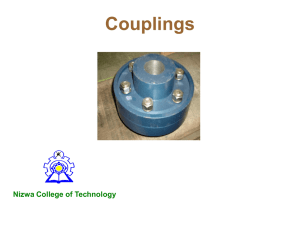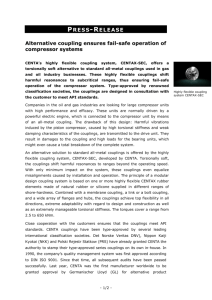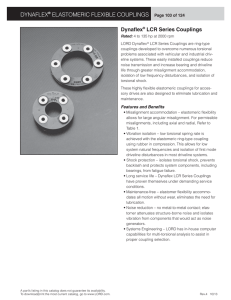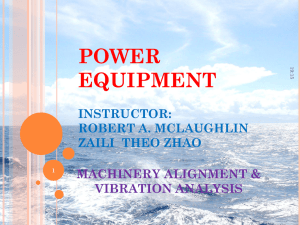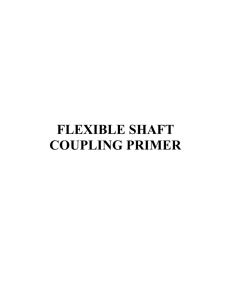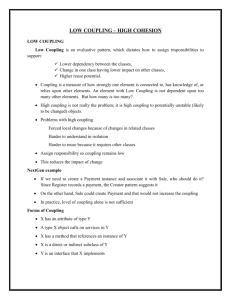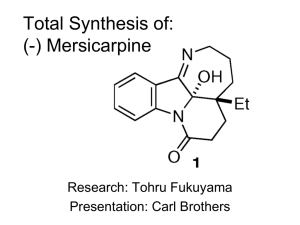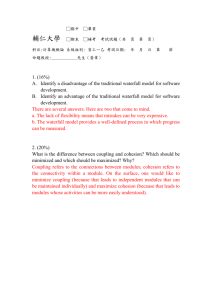Coupling_Selection - Heinzeroth Marketing Group
advertisement
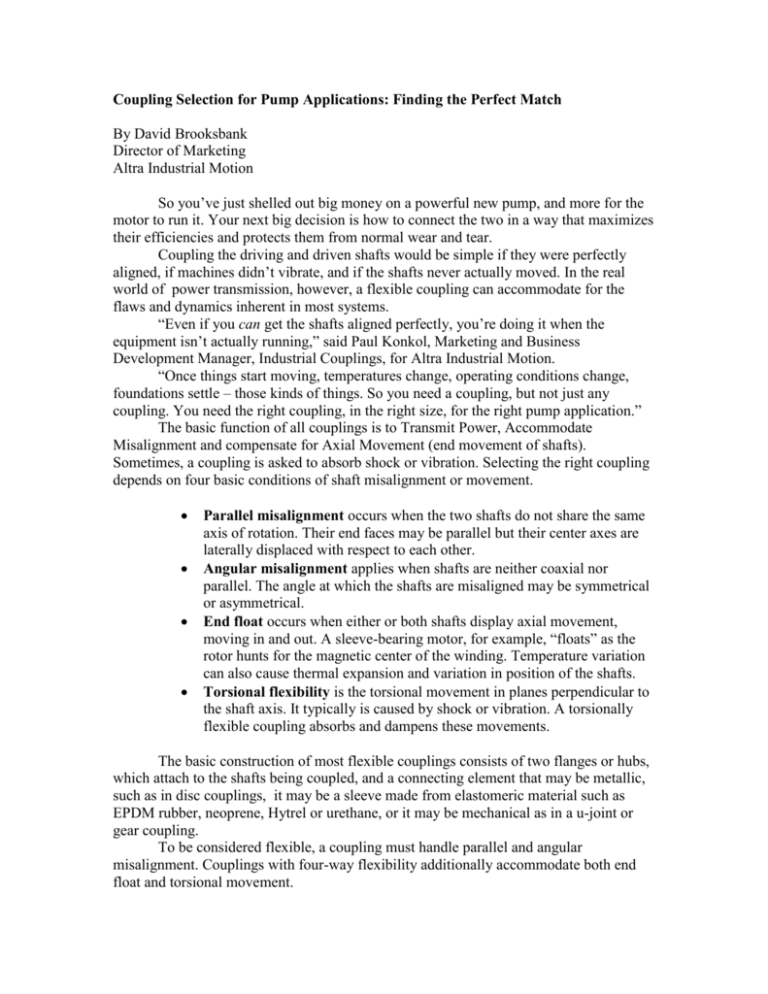
Coupling Selection for Pump Applications: Finding the Perfect Match By David Brooksbank Director of Marketing Altra Industrial Motion So you’ve just shelled out big money on a powerful new pump, and more for the motor to run it. Your next big decision is how to connect the two in a way that maximizes their efficiencies and protects them from normal wear and tear. Coupling the driving and driven shafts would be simple if they were perfectly aligned, if machines didn’t vibrate, and if the shafts never actually moved. In the real world of power transmission, however, a flexible coupling can accommodate for the flaws and dynamics inherent in most systems. “Even if you can get the shafts aligned perfectly, you’re doing it when the equipment isn’t actually running,” said Paul Konkol, Marketing and Business Development Manager, Industrial Couplings, for Altra Industrial Motion. “Once things start moving, temperatures change, operating conditions change, foundations settle – those kinds of things. So you need a coupling, but not just any coupling. You need the right coupling, in the right size, for the right pump application.” The basic function of all couplings is to Transmit Power, Accommodate Misalignment and compensate for Axial Movement (end movement of shafts). Sometimes, a coupling is asked to absorb shock or vibration. Selecting the right coupling depends on four basic conditions of shaft misalignment or movement. Parallel misalignment occurs when the two shafts do not share the same axis of rotation. Their end faces may be parallel but their center axes are laterally displaced with respect to each other. Angular misalignment applies when shafts are neither coaxial nor parallel. The angle at which the shafts are misaligned may be symmetrical or asymmetrical. End float occurs when either or both shafts display axial movement, moving in and out. A sleeve-bearing motor, for example, “floats” as the rotor hunts for the magnetic center of the winding. Temperature variation can also cause thermal expansion and variation in position of the shafts. Torsional flexibility is the torsional movement in planes perpendicular to the shaft axis. It typically is caused by shock or vibration. A torsionally flexible coupling absorbs and dampens these movements. The basic construction of most flexible couplings consists of two flanges or hubs, which attach to the shafts being coupled, and a connecting element that may be metallic, such as in disc couplings, it may be a sleeve made from elastomeric material such as EPDM rubber, neoprene, Hytrel or urethane, or it may be mechanical as in a u-joint or gear coupling. To be considered flexible, a coupling must handle parallel and angular misalignment. Couplings with four-way flexibility additionally accommodate both end float and torsional movement. Four-Way Flexibility An excellent example of a four-way flexible coupling with good torsional flexibility is an elastomeric coupling that operates in shear (as opposed to compression). In these, the elastomeric flexible member can deform or stretch in shear, displacing under a load. The amount of torsional displacement or “windup” of the elastomer is a measure of the shock that can be absorbed. It also compresses easily and stretches to handle end float. The torsional flexibility allows the elastomeric shear coupling to dampen the amplitude of vibrations, isolating one shaft from the effects of the other. In effect, the energy absorbed during shock loads is used to wind the elastomer in a twisting action. Since the force of the shock from the motor is reduced by the amount of energy expended in winding the flexible member, the pump shaft is cushioned from the shock. This energy is then released back into the drive system as the coupling unwinds. Elastomeric shear couplings will also fail under excessive shock loads and disconnect the pump from the motor to protect the pump in the event of a lock-up or any other condition creating excessive shock. “Couplings that use the elastomeric material in compression don’t have the same amount of misalignment capacity or axial or torsional dampening capabilities as when you’re running them in shear,” said Konkol. “In compression, you’re squeezing the rubber to transmit torque, rather than twisting it. “The molecular structure of the elastomer material in shear couplings such as the Sure-Flex is highly engineered because the material has to be much stronger to withstand shear forces. I liken it to the difference between cast metal and forged steel where, in forging, you basically align the molecular structure to make the material stronger.” Couplings for High Torque, High Speed While elastomeric couplings are popular for many general industrial pump applications running up to 115 HP/100 RPM, the limits of elastomeric materials are exceeded in applications that require transmission of higher torques and speeds. Gear, grid and disc couplings are metallic couplings that are more torsionally rigid and offer advantages in these applications. “Gear and grid couplings are excellent with higher torques, but as with anything, when you make gains in one area of design, there are things you have to give up in other areas,” Konkol said. “In this case, it is torsional dampening. These are stiffer couplings so more vibration is going to be transmitted through to the pump.” Gear couplings are constructed with a sleeve containing internal teeth that mesh with teeth on the outside of the hubs. Popular for both high-speed, high-horsepower and high-torque, low-speed applications, they work well in applications that require torsional rigidity. The fit of the teeth in a gear coupling allows for misalignment but the degree of compensation of angular misalignment depends on the contour of the gear teeth and the clearance between them. Because of their design, these torsionally stiff couplings can withstand some shock loading, but they cannot absorb significant amounts of it. Grid couplings consist of two grooved flanged hubs connected by a tapered steel spring in the form of a grid. Like gear couplings, they require lubrication, but allow for flexibility and efficiency at high speeds or at low speeds with high torque. Grid couplings can operate up to 400 HP/100 RPM. Being more rigid, their misalignment capabilities are not as great as elastomeric couplings, thus alignment of the motor and pump shafts is more critical. Disc couplings are extremely uniform in design and can rotate at very high speeds. Pumps operating at high RPMs are good applications for these well-balanced, smooth operating devices that, like elastomeric couplings, require no lubrication. Disc couplings, however, are quite complex designs and are extremely sensitive to misalignment and axial movement. Flexing of a disc or metallic component beyond its yield point can cause fatigue, and axial movement can cause failure. Size Matters With coupling selection, pump users should beware the trap that “more is better”. Oversizing a coupling can result in a reduction in needed flexibility or misalignment compensation, and a coupling that is too large can put additional stresses on the pumps and motors being coupled. On the other hand, a coupling with too much misalignment capacity may be too soft or “compliant” which can cause vibration or an unbalanced condition in rotation. “For general industrial applications, Sure-Flex is a great coupling. For turbinedriven equipment running at 3,000 RPM or higher, you may want a disc coupling,” Konkol said. “For high torque, a gear or grid coupling may be the right choice. “It’s all about putting the right coupling in the right application, so that’s where the manufacturer can be a valuable asset in the selection process. Within Altra’s Global Couplings Group, we’ve got a wide range of coupling products. Ameridrives Couplings, TB Wood’s and Bibby Transmissions have been standards in pump applications for decades. That engineering knowledge base can be a real value-added service to the user.” 1275 words
